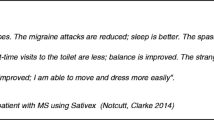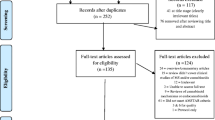Abstract
The endocannabinoid system (ECS) is involved in the pathophysiology of multiple sclerosis (MS), and relief from pain and spasticity has been reported in MS patients self-medicating with marijuana. A cannabis-based medication containing Δ9-tetrahydrocannabinol and cannabidiol (Sativex®) has been approved in some countries for the treatment of MS-associated pain. The effects of this pharmaceutical preparation on other clinically relevant aspects of MS pathophysiology, however, are still unclear. In 20 MS patients, we measured the effects of Sativex® on clinically measured spasticity and on neurophysiological and laboratory parameters that correlate with spasticity severity or with the modulation of the ECS. Sativex® failed to affect spasticity and stretch reflex excitability. This compound also failed to affect the synthesis and the degradation of the endocannabinoid anandamide, as well as the expression of both CB1 and CB2 cannabinoid receptors in various subpopulations of peripheral lymphocytes.
Similar content being viewed by others
Avoid common mistakes on your manuscript.
Introduction
Reduced frequency of relapses, and relief from spasticity, dystonia, tremor, ataxia, and pain have been reported in multiple sclerosis (MS) patients self-medicating with marijuana [1]. We have recently described the involvement of the endocannabinoid system (ECS) in MS pathophysiology, and we have postulated that enhancing cannabinoid signaling in lymphocytes and neuronal circuits might result in widespread beneficial effects in patients suffering from this disorder [2]. Based on these premises, in the present study, we investigated the effects of a cannabis-based pharmaceutical preparation containing Δ9-tetrahydrocannabinol and cannabidiol (Sativex®) on spasticity and on some neurophysiological and laboratory parameters that correlate with spasticity severity [3] or with the modulation of the ECS [2].
Sativex® has been approved as a second-line therapy in the treatment of chronic neuropathic pain (CNP) in MS, and this offered us the possibility to prescribe this pharmaceutical preparation in MS patients treated in normal clinical practice. In these patients, clinically measured spasticity, the excitability of the stretch reflex, the synthesis and the degradation of the endocannabinoid anandamide, and the expression of both CB1 and CB2 cannabinoid receptors in various subpopulations of peripheral lymphocytes were measured before and after Sativex® treatment.
Subjects and methods
In a sample of 20 MS patients (13 female, aged 21–51 years) with CNP refractory or intolerant to commonly prescribed medications (gabapentin, pregabalin, and antidepressants), Sativex® was administered for a 6-week period. Pain, but also lower limb spasticity (which co-existed in 11 of these patients), H/M ratio [3] and other laboratory measures were evaluated.
Patients gave their written informed consent to the study, which was approved by the Local Institutional Ethical Committee. This Ethical Committee, however, did not approve the use of the placebo in this study, because Sativex® has already been approved for the treatment of pain in MS subjects. CNP was defined as a constant or intermittent sensory symptom with unpleasant feelings or pain, lasting for more than 1 month and having a stereotyped neurological distribution and superficial localization. All except three patients had pain in the lower extremities. Concomitant medications and therapies were maintained during the study. Exclusion criteria included psychosis, substance abuse, cardiovascular disorders, and pregnancy.
Subjects were instructed to titrate their daily dose of Sativex® steadily as required over 2 weeks, to a maximum of 40 sprays per day. Pain intensity was evaluated at study entry (W0) and each week for six consecutive weeks (W1–W6) using the 100 mm visual analog scale (VAS) for pain, ranging from “no pain” to “worst possible pain”. A similar 100 mm scale ranging from “no relief” to “complete relief” was administered to the patients at W3 and the end of the study to evaluate the subjective effect of Sativex®. Spasticity was evaluated at baseline and on a weekly diary assessment by the subject on a 0–10 numerical rating scale (NRS) [4]. The Ashworth score for spasticity [3] was also calculated each week at W0–W6. At W0 and W6, each patient underwent a neurophysiological evaluation to measure H-reflex, a reliable electrophysiological measure of stretch reflex, and the ratio between the amplitude of H response and that of the soleus compound motor action potential (CMAP) (H/M ratio). H/M ratio reflects spinal excitability and has been reported to be oppositely modulated by spasticity as well as by antispastic treatments [3]. Disability, depression, and quality of life were evaluated at W0 and W6 using, respectively, the Expanded Disability Status Scale (EDSS), the Hamilton Depression Inventory Scale (HDS), and the MS quality of life-54 auto-questionnaire (MSQoL-54).
Finally, all patients also underwent blood withdrawal at W0 and W6 to measure, in lymphocytes, the activity of N-acyl-phosphatidylethanolamines (NAPE)-hydrolyzing phospholipase D (NAPE-PLD) and of fatty acid amide hydrolase (FAAH), enzymes involved in the synthesis and degradation of the endocannabinoid anandamide, respectively. Accordingly, changes in the activity of NAPE-PLD, FAAH, and in the expression of cannabinoid receptors in peripheral lymphocytes have been previously shown to be significantly altered in MS, and to correlate with the severity of the inflammatory process [2]. The hydrolysis of [3H]AEA by FAAH and the synthesis of AEA by NAPE-PLD were assayed as described in Ref. [2].
Also, the percentage of lymphocyte subpopulations and the expression of cannabinoid CB1 and CB2 receptors on these cells were measured in MS patients at W0 and W6. To achieve this objective, freshly isolated PBMC were washed twice with PBS and stained with anti-rabbit CB1 or anti-rabbit CB2 purified antibodies. After, they were stained with goat anti-rabbit APC, anti-CD56 PE, anti-CD19 PE-CY7, anti-CD3 APC-CY7, anti-CD8 CY and anti-CD14 FITC at 4°C. After 20 min they were washed twice and they were analyzed on FACSCANTO cytometer.
Results
None of the clinical, neurophysiological and laboratory parameters were significantly affected by Sativex®, which was generally well tolerated (Fig. 1). Sativex® was not able to reduce pain in MS subjects, since no significant effect over time was observed in mean VAS for pain. The mean VAS score for pain relief was particularly low both at 3 (W3) and 6 weeks (W6) of treatment. Spasticity, evaluated weekly by the subjective numerical rating scale (NRS) and by the objective Ashworth score, was also unaffected by Sativex®.
Sativex® does not affect any of the clinical, neurophysiological, and laboratory parameters analyzed. Statistical analysis was performed using one-way or two-way ANOVAs for repeated measures in the case of parametric data or by Kruskal–Wallis test in the case of non-parametric data. Comparisons between two groups were analyzed by Student’s t test. Clinical (a–c) and laboratory data (f–h) were presented as the mean ± SD. Neurophysiological (d) and biochemical data (e) were presented as the mean ± SEM. The significance level, established at p < 0.05, was not obtained in any analysis
H/M ratio obtained by neurophysiological evaluation of both lower limbs [3] was not modified by 6-week Sativex® treatment. This compound also failed to modify the activity of both FAAH and NAPE-PLD, enzymes involved in the metabolism of the endocannabinoid anandamide. The percentage of lymphocyte subpopulations and the expression of both cannabinoid CB1 and CB2 receptors on peripheral lymphocytes were not significantly modified by 6-week Sativex® treatment.
Sativex also failed to modify EDSS, HDS, and MSQoL-54 scores (not shown). One patient discontinued the treatment after 2 weeks because of the occurrence of hallucinosis. Sedation, dizziness, and nausea were the most frequently reported adverse events.
Discussion
The present results argue against the efficacy of cannabis-based medicine for symptomatic relief in MS patients with CNP or spasticity, although previous findings reported that 4–6 weeks of Sativex® treatment were enough to achieve some therapeutical [4, 5] or neurophysiological effect against pain [6]. Conversely, our results are in line with a more recent finding showing that Sativex® effects were indistinguishable from those of the placebo in a large sample of MS patients [7].
Our results also show that spinal cord excitability does not change during Sativex® treatment, although a prominent role of the ECS in spinal control has been reported [8]. In line with the idea that cannabis derivatives are unable to interfere with the ECS, we have failed to observe modulation of anandamide metabolism and of cannabinoid CB1 and CB2 receptors by Sativex®.
The relatively small number of subjects included in this study and the absence of a placebo arm are the major limitations of the present study, although the negative clinical, neurophysiological and laboratory results reported here clearly indicate that no significant placebo effect occurred during the study. The use of cannabis derivatives in MS patients should be considered more cautiously.
References
Baker D, Pryce G, Giovannoni G, Thompson AJ (2003) The therapeutic potential of cannabis. Lancet Neurol 2:291–298
Centonze D, Bari M, Rossi S, Prosperetti C, Furlan R, Fezza F, De Chiara V, Battistini L, Bernardi G, Bernardini S, Martino G, Maccarrone M (2007) The endocannabinoid system is dysregulated in multiple sclerosis and in experimental autoimmune encephalomyelitis. Brain 130:2543–2553
Collin C, Davies P, Mutiboko IK, Ratcliffe S (2007) Sativex spasticity in MS Study Group. Randomized controlled trial of cannabis-based medicine in spasticity caused by multiple sclerosis. Eur J Neurol 14:290–296
Centonze D, Koch G, Versace V, Mori F, Rossi S, Brusa L, Grossi K, Torelli F, Prosperetti C, Cervellino A, Marfia GA, Stanzione P, Marciani MG, Boffa L, Bernardi G (2007) Repetitive transcranial magnetic stimulation of the motor cortex ameliorates spasticity in multiple sclerosis. Neurology 68:1045–1050
Rog DJ, Nurmikko TJ, Friede T, Young CA (2005) Randomized, controlled trial of cannabis-based medicine in central pain in multiple sclerosis. Neurology 65:812–819
Conte A, Bettolo CM, Onesti E, Frasca V, Iacovelli E, Gilio F, Giacomelli E, Gabriele M, Aragona M, Tomassini V, Pantano P, Pozzilli C, Inghilleri M (2008) Cannabinoid-induced effects on the nociceptive system: a neurophysiological study in patients with secondary progressive multiple sclerosis. Eur J Pain [Epub ahead of print]
International Association for Cannabis as Medicine (IACM) bulletin of 13 April 2008
Baker D, Pryce G, Croxford JL, Brown P, Pertwee RG, Huffman JW, Layward L (2000) Cannabinoids control spasticity and tremor in a multiple sclerosis model. Nature 404:84–87
Acknowledgments
This study was supported by grants from the Fondazione Italiana Sclerosi Multipla (FISM) to DC and LB; from the Italian National Ministero della Salute to DC and LB; from the Italian National Ministero dell’Università e Ricerca to DC; and from the Fondazione Tercas to MM.
Conflict of interest statement
The authors have no financial considerations to disclose or competing interests to this article.
Author information
Authors and Affiliations
Corresponding author
Additional information
L. Battistini and M. Maccarrone have equally contributed to the present work.
Rights and permissions
About this article
Cite this article
Centonze, D., Mori, F., Koch, G. et al. Lack of effect of cannabis-based treatment on clinical and laboratory measures in multiple sclerosis. Neurol Sci 30, 531–534 (2009). https://doi.org/10.1007/s10072-009-0136-5
Received:
Accepted:
Published:
Issue Date:
DOI: https://doi.org/10.1007/s10072-009-0136-5





